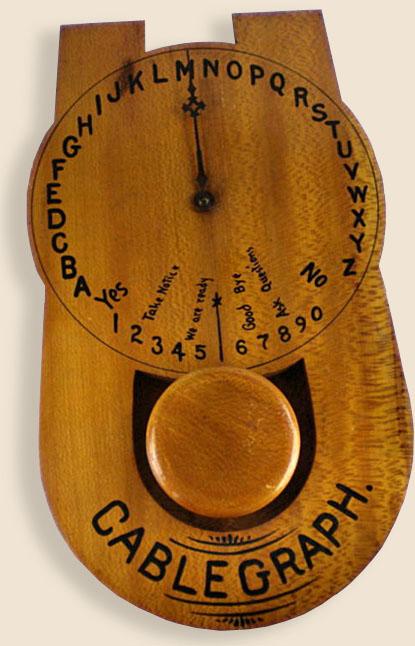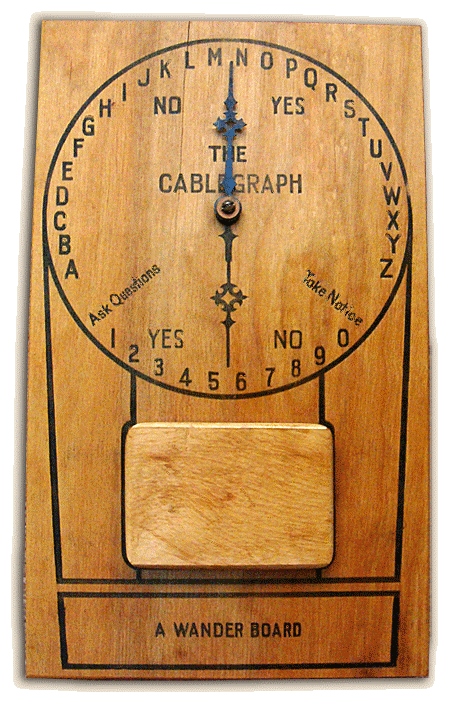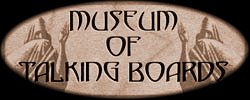
The
Cablegraph and A Wander Board
George Foster
Pearson took making dial plate talking boards
seriously as you can see by the two oak beauties on
this page. Presumably the spirits found them
equally attractive. The Cablegraph, patented in
1900, resembled a horseshoe magnet because Pearson
felt that magnetism had everything to do with
contacting the other side. That wood is not
magnetic didn't matter. It was animal
magnetism—that ethereal fluid that flows
mysteriously through the bodies of living beings
that was important. Using that magnetic force you
could power the board and thus contact the dead.
Or, so he claimed.
These instruments
were close relatives of earlier Pease-Hare dial
plate talking boards with several design
improvements. Pearson connected the touch pad to
the needle dial with a lever and gears rather than
the pulley and rope of the earlier models. This
made the action smooth and effortless. He spent
more time in the wood shop than with the typewriter
however, and after reading his rambling, run-on
instructions on the back of the board, one can't
help but think that he may have been drinking his
spirits rather than contacting them. This is
exactly as he wrote them, word for word:
|
The
Cablegraph
An
instrument for communication between the
world we now live in and the world we
live in after the change called
Death.
DIRECTIONS
FOR USING
After
seating yourself in a comfortable
position where you can allow free use of
your hands and arms. Place the instrument
in your lap or upon a table and upon the
circular top place the ends of your
fingers lightly having the free use of
the arms and shoulder muscles relaxed and
with the thoughts in mind explain that
you would be pleased to hear from someone
over there and sit in that position from
5 to 10 minutes, if it should not start
try one hand. It has to be magnetized, if
it should not start then have some other
person put their hands on the points of
fingers and so operate until you find the
one who will assist you (if you have not
the power alone) to operate it. When once
you find the ones to operate it, the rest
comes of itself, through itself be
patient and not bring too doubtful
conditions as conditions have a great
influence in the operating of the
Cablegraph, when once you have found the
right magnetic force for operating, then
ask questions and ask for your friends to
be brought in contact with you and the
machine and use your best judgment as to
the fact of their communication. Evenings
at the twilight hour is the best time to
receive messages.
George F.
Pearson, Inventor and Manf'r
27 Loring Street, Lowell, Mass
|

In 1919, Pearson
introduced an "improved" Cablegraph which he called
the "Wander Board." A modified horseshoe shape was
now incorporated into the design. If your magnetism
was low and you couldn't contact the spirits, at
least you could have fun trying as he stated in his
new patent: "The invention has relation to devices
operated or controlled by the hand or finger
pressure, whereby messages are conveyed from the
spirit world to the operator. Of course
irrespective of the use of this instrument to aid
or act as a medium in the transmission of spirit
messages, it is useful as an amusement device. It
is quite generally acknowledged nowadays however
that communications with the spirit world are
possible and not infrequent." The directions
printed on the back of the Wander Board were now
slightly more coherent.
|
DIRECTIONS
for the Cablegraph or Wander
Board
To
operate, lay the board on your lap or on
a table. Place the tips of your fingers
lightly on the disc, or sensitive key.
You may then ask questions audibly or
mentally, and the spirit impulse will
cause the disc to move to the right or
left, bringing the hand or pointer in
registration with the required letter,
number or phrase to spell out or convey
the message.
For the
majority of people, the Cablegraph will
establish communications with the Great
Unknown in a very few minutes, and
furnish the most astonishing answers,
facts and advice. Other persons require a
longer sitting, but persevere and the
Cablegraph will finally please, surprise
and mystify you.
The
Cablegraph will operate equally well when
two persons place their fingers on the
disc, provided the question is asked by
only one of the sitters at a time, to
prevent confusion.
Invented
by George F. Pearson
Indicator design patented May 29, 1900,
No. 32,739
Improved Cablegraph or Wanderboard Patent
Pending. Serial No. 306,730
Price $2.50 Each
Sole Mfrs.
Wanderboard CO.
Lowell, Mass., U.S.A. P.O. Box
1035
|
Back
to the Dial Plate Talking Boards.

You are visiting the Museum
of Talking Boards
Copyright © All Rights
Reserved.
|


